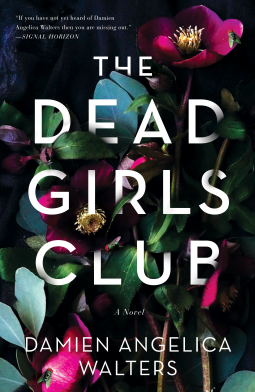
The Dead Girls Club by Damien Angelica Walters
Genre: horror/mystery/thriller
Publisher: Crooked Lane Books
Publication date: December 10, 2019
Blurb
A supernatural thriller in the vein of A Head Full of Ghosts about two young girls, a scary story that becomes far too real, and the tragic–and terrifying–consequences that follow one of them into adulthood.
Red Lady, Red Lady, show us your face…
In 1991, Heather Cole and her friends were members of the Dead Girls Club. Obsessed with the macabre, the girls exchanged stories about serial killers and imaginary monsters, like the Red Lady, the spirit of a vengeful witch killed centuries before. Heather knew the stories were just that, until her best friend Becca began insisting the Red Lady was real–and she could prove it.
That belief got Becca killed.
It’s been nearly thirty years, but Heather has never told anyone what really happened that night–that Becca was right and the Red Lady was real. She’s done her best to put that fateful summer, Becca, and the Red Lady, behind her. Until a familiar necklace arrives in the mail, a necklace Heather hasn’t seen since the night Becca died.
The night Heather killed her.
Now, someone else knows what she did…and they’re determined to make Heather pay. (from Goodreads)
My thoughts
This is billed as a “supernatural thriller.” I don’t read in the horror genre, nor do I read much dealing with the supernatural, so I can’t say how this book measures up against Trembley’s A Head Full of Ghosts or others in this category. As a thriller, I think it was a mixed success.
Dual timeline: the past
This novel is written in the ever-popular dual timeline format.
In the “now,” we follow adult Heather as she receives the necklace in the mail and hunts for who sent this to her. In the “then” sections, we follow Heather and her other friends during the summer between 7th and 8th grade. Becca tells stories about the Red Lady. They’re fascinated. But as the summer progresses, “fascinated” becomes “obsessed.” As you’d expect, the two timelines converge at the end.
At first, the “then” sections didn’t interest me. When I was 12-13 years old, the supernatural wasn’t enthralling to me. Ditto for scary stories, ghosts, anything macabre. Never played Bloody Mary or Light as a Feather. In other words, the girls of the Dead Girls Club would’ve kicked me out if a) we’d known each other, and b) they weren’t fictional characters.
Even so, there were things in those sections that rang true in my memory. The mistaken idea that once you make a promise, you must keep it. The equally mistaken idea that adults don’t have a clue and can’t help. The idea that best friends stay best friends forever.
Walters does a great job capturing the teen mindset and how easily they succumb to obsessions not easily understood by the adults around them.
Because of this, by the end of the book, the “then” sections captured my attention. I read quickly, eager to learn what happened to Becca.
Dual timeline: the present
The opposite was true of the “now” sections. At first, I was curious about Heather’s reactions. But as her mental state rapidly deteriorated, her decisions became self-defeating and hurtful, both to herself and others. Just like Becca became obsessed with the Red Lady and was convinced only the Red Lady could help her, Heather becomes obsessed with finding out who knows “the truth.” She can’t think rationally.
After a certain point, I (along with another character) lost patience with her. She’s a trained child psychologist. Yet she behaves unprofessionally: forgets to take notes during sessions; zones out during group sessions with volatile teens; and reschedules patients’ appointments so she can hunt for whoever continues to send her items from the past.
(As a mom, I feel badly for the guardians of her child clients who have undoubtedly taken off from work, specifically chosen a particular time to fit into the child’s school/activity schedule, and will not be happy at last minute cancellations. Like I said, Heather’s not being professional, nor empathetic to her clients’ needs.)
At this point, she appears to need counseling more than give counseling.
An unreliable narrator
It’s also increasingly apparent that she’s an unreliable narrator. How much of what she tells us is real? How much is delusional? Is her memory reliable? For example, we hear the Red Lady stories through Heather’s first person point of view memories from thirty-odd years before. Were these really the stories that Becca told? Have the stories been colored by Becca’s fate?
While I can enjoy an unsympathetic, unreliable narrator, these characters are tricky to pull off. (The type of narrator has also been overused in recent years, in my opinion.)
Heather’s paranoia escalates quickly. Rather than a gradual mental breakdown, which would feel more compelling and understandable for most readers, her reactions become overreactions.
While I understand her desire to keep this a secret, her continual secrets and lies make her previous stability seem unbelievable. How on earth was this woman able to function well enough (without counseling, apparently) to get a doctorate in psychology? Of all people, she should know the dangers of keeping secrets; she kept the secret of Becca’s mother’s “problems” even when questioned by her parents, with disastrous results.
At the same time, though, I understand why she’s haunted by Becca. She turned a blind eye to her best friend’s need, and when she did try to help, she only hurt her. That’s not a decision that can be undone.
I remember being a teen and responding inadequately to friends in similar circumstances. The evidence was right before my eyes but I was too naive, too preoccupied with myself to act in my friends’ best interest. (Yes, plural.) Those times of willful blindness haunt me to this day. As I read this book, I thought about them. No one died, but if they had . . . Who’s to say that I wouldn’t be as paranoid as Heather?
All that to say, while I frequently lost patience with her, I also saw certain elements of myself reflected in her. And that scared me more than any Red Lady story.
The ending
No spoilers. But I had mixed feelings about the ending. It felt like the conflict both was and wasn’t resolved at the same time. Still, I don’t know what a better ending would be.
In the end, The Dead Girls’ Club is worth reading.
Here’s why: Walters beautifully captures the early teen mindset of all-or-nothing thinking. Heather and Becca’s story serves as a sober reminder that the stories we tell ourselves are rarely only stories, obsessions can turn deadly, and turning a blind eye to those in need will haunt you for life. Recommended to suspense fans.
Thanks to Crooked Lane Books and Netgalley for a copy of The Dead Girls’ Club in exchange for an honest and unbiased review.
